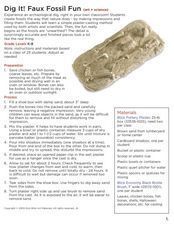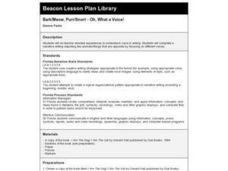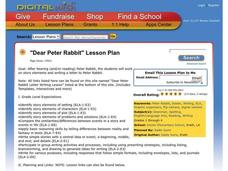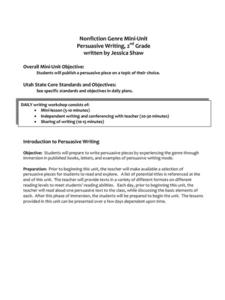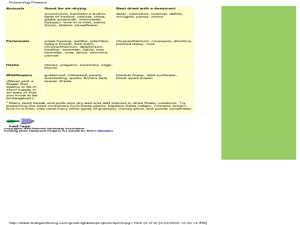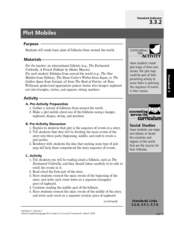Curated OER
Accordion-Book Summary
In this language arts worksheet, students will complete an accordion book to summarize a story. Students are provided with the directions to complete the book and prompted to write about the beginning, middle, and end of their selected...
Curated OER
Faux Fossil Fun
Elementary schoolers investigate how fossils are created by reproducing the process of creating an impression and filling it with a hardening material. The art lessons from this source are just fantastic! The lesson plan is well-written...
Curated OER
Bark, Meow, Purr, Snort - Oh, What a Voice!
Students brainstorm differences between dogs and cats. They discuss the elements that make a story effective and write a story with a beginning, middle and end in the voice of a cat or dog.
Curated OER
Open Sesame: A Magical World of Reading
Third graders, through six lessons, study tales of Ali Baba and the Forty Thieves and Aladdin and the Lamp from The Arabian Nights.
Curated OER
Dear Peter Rabbit
Write dear old Peter Rabbit a letter with this lesson. First, youngsters listen to the story Peter Rabbit and analyze the story elements. Then they complete a story map graphic organizer in order to write a letter to Peter...
Curated OER
Write a Story
Here is a great way to explore narrative writing! Learners review a previously constructed story map and identify the characters, setting, and main events in the book Anansi and the Moss-Covered Rock retold by Eric A. Kimmel. They...
Curated OER
Compare and Contrast
Students write a paragraph. In this writing lesson, students review what a paragraph is and how it contains a beginning, middle and end. Students also learn how to write comparison and contrast paragraphs.
Curated OER
Cooperative Comics
Students create comics identifying conflicts and their resolutions. In this conflict resolution lesson, small groups of students follow specific mapping instructions to illustrate a conflict and its resolution. Students present orally...
Curated OER
Generations: An Exploration of our Families Through Literature
Students complete a unit of lessons on families. They read and analyze various stories, label a map, assemble sentences, write letters to grandparents, analyze character traits, and write and illustrate a sheet for a class book.
Curated OER
Artist Mice Art Nice
Students help create "Art picture frames" that display their own artwork throughout the year in this exciting lesson for the pre-Kindergarten classroom. The "frames" are then decorated with small mouse cutouts and pictures of each student.
Curated OER
How Can We Write A Story Using Dr. Seuss' Writing and Illustration Style?
Students write a story. In this writing style and illustration lesson, students review elements of Dr. Seuss' writing and illustration style and read a few more books written by him, examining the writing style. Students work...
Curated OER
What Can I Write About When I Can't Think of Anything To Write About?
Third graders write, illustrate, and publish a collaborative story. In this writing lesson, 3rd graders review story elements by reading stories written by professional authors and other students. They work in groups to write a...
Curated OER
Nonfiction Genre Mini-Unit: Persuasive Writing
Should primary graders have their own computers? Should animals be kept in captivity? Young writers learn how to develop and support a claim in this short unit on persuasive writing.
Federal Reserve Bank
The Little Red Hen Makes a Pizza
Make a study of producers and consumers with an updated version of the classic story The Little Red Hen (this one is called The Little Red Hen Makes a Pizza). After reading and discussing the story and terms, learners practice being...
Curated OER
Preserving Buds and Blooms
Students learn how to preserve flower buds and blooms. In this gardening lesson, students explore the methods of air drying, using drying agents, and pressing plants to preserve them.
Curated OER
Narrative Writing
A basic lesson on personal narrative writing is here for you. In it, learners are asked to imagine they're going to share an experience of their own with someone who did not participate in that experience. They verbally tell the story to...
Curated OER
And the Moral of the Story is...
Students retell a story using computer software. In this story elements lesson, students retell the story giving the plot, setting, characters and moral using Pixie software.
Curated OER
Verdi
Third graders explore language arts by answering study questions about a book they read. In this reading summary lesson plan, 3rd graders read the book Verdi by Janell Cannon and identify the plot, characters and sequence of the story....
Curated OER
Plot Mobiles
Students read folktales and identify the plot of the story by making a mobile. For this inventive and colorful lesson, students listen to a variety of famous folktales, and practice identifying the plot. Then, they work together to...
Curated OER
Amazing Animal Alliteration Book
Students understand the meaning of alliteration. In this alliteration lesson, students write sentences using alliteration and recognize how it changes the writing in a story.
Curated OER
Alexander and the Terrible, Horrible, No Good, Very Bad Day
Learners investigate storytelling by analyzing images in a book. In this reading analysis lesson, students read and analyze the book Alexander and the Horrible, No Good, Very Bad Day. Learners observe the illustrations in the...
Curated OER
Historic Places in Kansas
Third graders explore the significance of historical landmarks. In this lesson, 3rd graders participate in a class discussion on Kansas landmarks, then complete several activities the reinforce the class discussion, such as writing a story.
Curated OER
Making Recycled Paper
Students explore the advantages of recycling paper. In this environmental lesson plan, students produce recycled paper by ripping up paper and putting it into a blender with water to create a mixture. Students use their recycled paper to...
Curated OER
Poetry Cut-Ups
Students write with controlled and/or subtle organization. They sustain a logical order. Students include a recognizable beginning, middle and end. Students begin by selecting a narrative poem.

